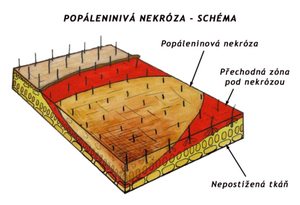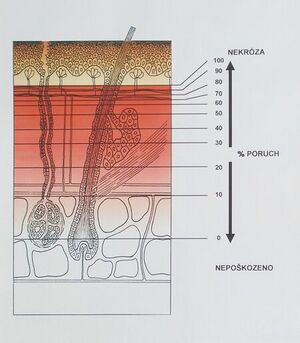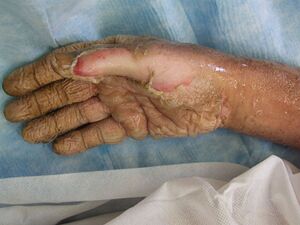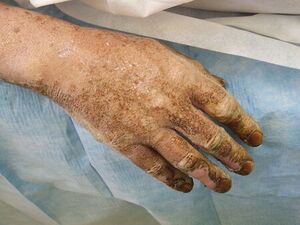Transition zone and thermal gradients
Necrosis is a layer of dead tissue that has no hope of recovery, so it is necessary to remove it as soon as possible. Burn IIb and III. St. it has another easily detectable layer under the layer of necrosis. It is the so-called transition zone (intermediate zone or stasis zone).
It can be divided into two other parts, namely the superficial – the zone of early stasis, which occurs within 2 hours after the injury, and the deeper – the zone of delayed stasis, which develops 4–16 hours after the burn and begins to subside within 24 hours. The changes are caused by microcirculation disorders and their severity increases towards the lower limit of coagulation necrosis (Zawacki 1987).
Thermal gradients
If we were to use the traditional designation of lethal dose (LD) used in experimental medicine, then below the lower edge of necrosis (which has an LD of 100 for cells) there would be layers of cells with LD 90, 80, 70... quite continuously up to LD 0, where acute thermal injury is no longer recorded by the cells. The gradient will follow the laws of physics and the impairment will decrease with the square of the distance. According to Zawacki's laboratory experiments, early necrosis would cause cell layers up to LD 20 to collapse within a short time, and only the less affected layer would be able to survive. It has also been repeatedly verified in clinical practice, with insufficiently performed tangential excision of necrosis . For tangential excisions, the rule is that the terminal incision must be made in a healthy and fully vital layer of tissue.
If we know the exact mechanism of the injury from the anamnesis, we can preoperatively estimate the depth of the injury, where we should look for the fully vital layer, and accordingly adjust the calibration of the instrument for necrotomy.
Surgical treatment
The question is how to approach this transition layer from the surgeon's point of view. They are supporters of the maximum preservation of viable tissues, while others rightly fear that with a surgical procedure, when the incision is made just below the necrosis, these barely surviving cells will be mechanically destroyed and the burn will thus deepen, which practice also indicates. (Persistent pathological changes of fibroblasts in later protein production may also be responsible for extreme collagen overproduction and hypertrophy of scars after healing). If we choose a gentler technique for removing necrosis by applying a necrolytic (ointment with a content of 40% salicylic or benzoic acid), necrosis and probably all layers incapable of further survival are separated, so we place the transplant only on the layer of vital cells. Even late cosmetic results tend to be more favorable. However, it is necessary to rule out infectious complications.
Since heat is mainly conducted from the first moment it comes into contact with the skin, time is a key factor. This, together with the temperature of the noxy, determines how much thermal energy was transferred to the organic structures. In principle, the heat will spread with the square of the distance, which in practice is manifested by the most serious damage on the surface and decreases with the increasing depth of the faults. Thermal gradients differ according to the mechanism of thermal injury. If we treat a patient who suffered a scald with water vapor at a temperature of 900 °C and the injury was caused during unconsciousness as a result of a collapsed state or an epileptic paroxysm, the injury will affect the deep structures of the skin and subcutaneous tissue as a result of long exposure, and the transition zone will be pronounced. The permanent effects will be much more severe than a contact burn with short-term exposure, even if the temperature is close to 10,000°C, or even 30,000–50,000 °C in the case of a flame burn or in the case of a short electric arc burn. In these cases, the damage is limited to the skin only, at a depth of IIa–IIb century, the subcutaneous tissue is mostly intact and the transition zone is narrow.
Links
Source
- KÖNIGOVÁ, Radana – BLÁHA, Josef, et al. Comprehensive treatment of burn trauma. 1. edition. Praha : Karolinum, 2010. ISBN 978-80-246-1670-4.
Literature
- Bláha Josef.: Sequelae of insufficient excision of deep dermal burns. Panel na kongresu EBA v Gröningen 1982
- BLÁHA, Josef. Permanent Sequelae After Burns and Tested Procedures to Influenced Them. Acta Chirurgiae Plasticae. 2001, vol. 43, Issue 4, p. 119 – 131,
- Zawacki B.E.: The Local Effect of Burn Injury In: Boswick J.A Jr. The Art and Science of Burn Care. Aspen Publishers, Inc. Rockville, Maryland 1987 pp 25 – 36




